Sign up for Chalkbeat Chicago’s free daily newsletter to keep up with the city’s public school system and statewide education policy.
Mónica Meléndez spent the first half of the last school year driving her three kids at least an hour each way to Inter-American Magnet School in Lake View.
She felt she had no choice after the district said it would not provide transportation at the beginning of the year for two of her children.
By the time all her kids got bus service in the second semester, Meléndez was exhausted — especially on days she spent another hour driving to work.
So shortly after Chicago Public Schools announced this summer that it wouldn’t provide busing to about 5,500 eligible general education students, largely those in gifted and magnet programs, Meléndez and her husband pulled their two youngest children out of the school. It was a wrenching decision: The Spanish dual language school felt perfect for the couple, who are originally from Puerto Rico and want their children to be bilingual.
Meléndez recalls telling her husband: “Sweetie, I can’t do this anymore.” Their oldest, a seventh grader, now takes a CTA bus two hours each way.
The family’s decision illustrates one way Chicago’s school bus crisis could impact enrollment and the socioeconomic and racial diversity of the city’s magnet and gifted programs. Many of these schools were created under a federal desegregation consent decree, but have been criticized for lacking diversity and enrolling larger shares of white and Asian American students since federal oversight ended in 2009. As working-class families find it difficult or impossible to take their children far distances to school, the absence of a transportation option could segregate the schools even more.
Parents at Inter-American are looking for solutions, as other gifted and magnet programs have also sought their own alternatives to the lack of busing.
Inter-American is already seeing the impact and some families have left.
“I would be really worried about what this change would mean for the demographics for these schools and for the goals of magnet schools in Chicago more generally,” said Halley Potter, an expert on school integration policy and a senior fellow at The Century Foundation.
Parents share transportation challenges
Citing a severe driver shortage, Chicago Public Schools announced in late July that it would limit bus transportation this year to students with disabilities and those who are homeless, both groups which are legally required to receive transportation. The district is currently under state watch to make sure it’s meeting those legal requirements.
The district said it has pursued several solutions to hire more drivers, including boosting driver pay rates by $2 – to $22 to $27 an hour – and hosting hiring fairs. But as of late last month, the district still had only half the number of drivers on hand and announced that busing would not be extended to more families for the rest of the semester. The district offered CTA cards to the 5,500 children who lost busing, but as of late last month, just about 1,600 took that option.
In a statement, CPS spokesperson Samantha Hart said the district is “acutely aware” of the challenges families are facing with longer commutes.
“We are committed to continuing to work with our vendors, City partners and our families to identify solutions and ensure every eligible student has safe, secure, and reliable transportation to and from school,” Hart said.
The transportation crisis has already had a small impact on enrollment at Inter-American, where nearly half of the school’s 641 students come from low-income families. Fifty-three families were eligible for transportation at the school. As of Oct. 2, six children have transferred out of the school due to the lack of transportation, according to the district.
At least two more children transferred out after Oct. 2 because of transportation issues, said Maria Ugarte, chair of Inter-American’s Local School Council. Ugarte has also heard from many parents who are considering leaving, and she wonders how lack of busing will impact next year’s enrollment.
At a meeting last month with the school’s principal, one parent said he wasn’t sure how much longer he could keep up the commute to school. A mother shared that her commute involves taking the CTA with her three children, including a 2-year-old, every morning and evening— and doing that daily is becoming stressful.
Alexis Luna, who lives in Belmont Cragin, splits dropoff and pickup responsibilities for her third grade daughter with the girl’s father. But her daughter may have to miss school on days that the girl’s father is out of town for work, since Luna’s work schedule is inflexible and she can’t take days off.
Luna “lost everything” when her business closed during the pandemic, so she cannot afford to miss work or quit. She said she is struggling to pay for the increased gas costs.
For Rocio Meza, the lack of transportation means she can’t search for a job this year as she handles the hourlong pickup and dropoff each way at Inter-American for her 12-year-old daughter. She’s also responsible for driving her older son with disabilities to doctor’s appointments on some mornings, which sometimes makes one of the children late.
She and her husband have discussed transferring their daughter out of Inter-American – two other schools are within a few blocks of their house – but the family loves the school.
”Do I really want to do this and give up the education and experience she’s getting at Inter-American to go to another school?” Meza said.
Some attempts to find solutions at the school level haven’t come to fruition.
The school’s principal, Juan Carlos Zayas, launched a voluntary task force with parents to look for ways to ease the transportation issue. Ideas included a rideshare app and hiring a bus company on their own, according to recordings of the meetings. Both options would likely be too costly for parents, task force members said. For example, one parent found a company that would charge $158 per child this month — if the bus was full with just a couple of stops.
The district granted the school $157,000 in funding to host before- and after-school programs to accommodate more flexible pickup and dropoff times. The principal recently surveyed families for their interest and expects programming to start Oct. 23, a district spokesperson said.
Last month, Luna tried to distribute a survey to arrange carpooling for interested parents. The survey asked for information such as where their child’s old bus stop was and how many children they had. Zayas emailed Luna and several other parents that the “attempt to collect personal information” was a “clear violation” of district policy and that it was circulated to teachers without his knowledge.
District officials pointed to a CPS policy that prevents anyone from circulating ads, subscription lists, meeting invitations, books, maps, articles, or other political or commercial materials among school employees or students without approval from the principal or other district officials.
Still, some parents are trying to figure out carpool arrangements, Luna said.
Transportation woes could decrease diversity in magnet programs
During CPS board meetings, parents at magnet and gifted programs have said they are worried that the lack of transportation will most greatly impact children whose parents don’t have flexible work schedules to take young children on lengthy transit commutes or the money and time to drive them. That could force less-resourced families to transfer out of magnet programs or gifted programs or choose not to apply for them for next school year.
Once seen as a solution to the city’s segregated schools, the city’s magnet, gifted, and selective enrollment programs have been criticized for failing to achieve their diversity goals. A 2019 WBEZ analysis found that just 20% of these schools met the definition of racial diversity embedded in a now-lifted court order for Chicago to integrate its schools.
CPS uses a lottery for enrollment in magnet programs like Inter-American. Seats are offered based on the socioeconomic status of the neighborhood a student lives in. Sometimes priority is given to siblings or to students living close to the school.
Inter-American lacks racial diversity — 85% of its students this year are Hispanic, and 10% are white, according to district data. However, the school is more socioeconomically diverse, with 47% of its students coming from low-income families, still far below the district’s average of about 71%.
During one of the task force meetings, one parent expressed concern that working-class families would leave, and more local families from the surrounding affluent Lake View neighborhood would get seats — changing the face of the school.
At the same time, less transportation for magnet and gifted families could mean more students enrolling in their neighborhood schools. Bolstering neighborhood schools is a priority for Mayor Brandon Johnson.
After pulling her daughter and son out of Inter-American, Meléndez enrolled them in her local neighborhood school, Canty Elementary. There, about half of the students are Hispanic, 44% are white, and about 2% are each Black and Asian American. Just over 43% come from low-income households.
Her daughters like the school so far, Meléndez said. Canty, which is not a dual-language school like Inter-American, is just a five-minute drive away from home. But the outcome of their story is likely not the norm: In a city as segregated as Chicago, more integrated neighborhood schools like Canty are a rarity.
Potter, from The Century Foundation, said Chicago Public Schools has done “really important work” in finding ways to spur diversity in selective and magnet schools. The district’s lotteries that try to enroll students from different socioeconomic backgrounds often result in more racial diversity, too, she said.
But, Potter said, “without transportation support, a lot of that can fall apart.”
Reema Amin is a reporter covering Chicago Public Schools. Contact Reema at ramin@chalkbeat.org.






